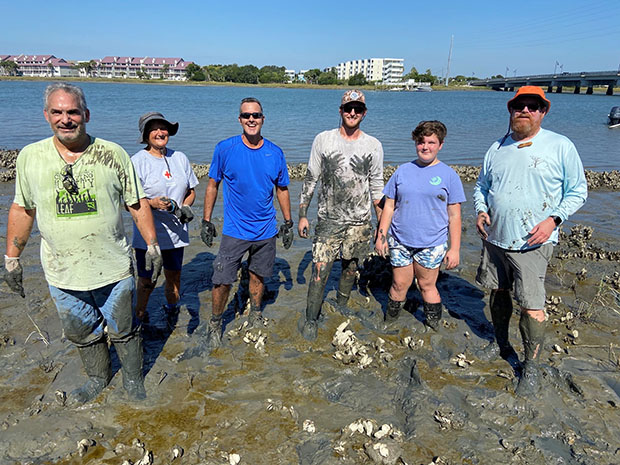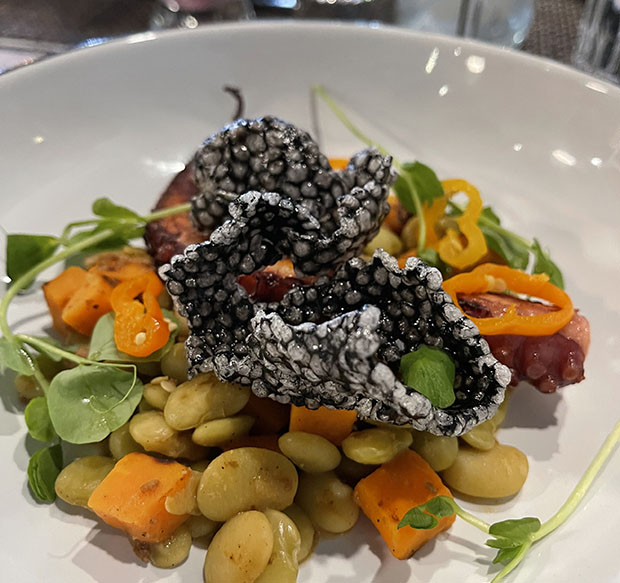Fields of Green
05 May 2022
Community volunteers harvest, replant marsh grass to create a more resilient ecosystem
By Jenny Peterson
Photos by Mike Ledford/The College of Charleston

The Lowcountry landscape has many iconic vistas, but none is more recognizable than the expansive marsh with swaths of marsh grass that ushers residents and visitors through the coastal waterways.
Changing colors from bright green in the summer to wheat in the winter, the Lowcountry’s colonies of dense Spartina cordgrass grass grow directly out of the pluff mud and provide an important habitat and nursery for fish and wildlife; marsh grass provides a camouflaged spot for egrets eyeing their prey in the shallows and where fiddler crabs find food. The grass also helps mitigate flooding in barrier islands and stabilizes the shore.
While it’s a plentiful resource, stretching tens of thousands of acres throughout the Lowcountry, many environmental factors like erosion and natural die-off sparse out the smooth cordgrass on some shorelines, leaving patches of bare pluff mud.
Those bald spots are now getting a boost, thanks to a $560,266 grant to be spent over three years through the National Oceanic and Atmospheric Administration (NOAA) National Marine Fisheries Service (NMFS) which funds The Community Science Salt Marsh Restoration and Monitoring Project.
Through the project, more than 200 volunteers transplated 16,000 Spartina plants back into the marsh last spring at five designated sites in Charleston County, including the Folly River Landing, Brittlebank Park downtown and Charlestowne Landing in West Ashley, all under the watchful eye of experts at the S.C. Department of Natural Resources (DNR), the lead agency for the program. This year’s spring replanting will occur in late May or early June.
According to Elizabeth Vernon (E.V.) Bell, the marine education specialist with the S.C. Sea Grant Consortium, an agency partner in the program, sites for replanting are carefully chosen by DNR. Volunteers also create oyster reefs at the sites to maximize the replanting efforts.
“Ideally, it’s the perfect setup where you create an oyster reef and plant marsh grass behind it; all of it helps stabilize the marsh,” said Bell.
It’s a two-part effort volunteer effort; once in the winter to collect seeds and once again in late May or early June to plant the once-inch grass back into the pluff mud at the sites. Volunteers take an orientation class to learn how to identify and collect the seeds for harvesting and become trained as
community scientists. They use a smartphone data collection app to record salt marsh restoration information, including the number of seeds collected and number of plants transplanted.
“The Spartina will flower starting in August and September, and then they'll start to develop seeds in October or November; they look like brown rice grains,” Bell said. “You may see what looks like a really nice like seed head, and then you go to try to pull the seeds off and if they don't come off easily, then they're not ready. So, you want to make sure when you run your hands over the stalk that the seeds fall out in your hand with very minimal effort.”
Once seeds are harvested in Ziploc bags, the sprouts are planted by volunteers inside containers that are placed inside a refrigerator to mimic cool outside temperatures and recreate the natural dormancy phase of the grass.
Seedlings spend months growing inside the large refrigerators and are then transferred in early spring to greenhouses at both the Department of Natural Resources (DNR) site in James Island and at the College of Charleston. Every seed harvest and planting is done under the watchful eye of scientific experts. Other grant partners include the South Carolina Aquarium and Clemson University Cooperative Extension.
Collaborators then wait for the grass to grow—literally—patiently waiting until the grasses are formed enough to transplant back in nature.
During the transplating, volunteers find themselves ankle-deep in mud, often walking on temporary boards for stability, in order to replant the sprouted grass back to its natural habitat, squatting down or bending over to fully bury the root.
Grass is planted one foot apart, marked the morning of the replanting day with orange and yellow flags.
“With the marsh mud, it just adds another dimension and challenge,” Bell said.
It’s a messy task, but well worth it; the seedlings are small, but mighty.
“It's obvious to see where we plant where there’s just a patch of pluff mud and you can see (over time) that these plants have taken root and are starting to spread and really establishing themselves,” Bell said. “They'll propagate and then shoot up new stalks and will spread. And you'll get new shoots coming up in the marsh.”
Using volunteers to help us collect seeds and transplant the plants is an important aspect of the process, as the community members are able to see first-hand the importance of the marsh grass to the coastal environment. Part of the grant funding includes long-term monitoring of the restoration sites by these community scientists. Similar efforts are conducted throughout the coastal United States, including North Carolina, Louisiana and Texas.
“Members of community learn why this plant is so critical to the salt marsh and why the salt marsh is so critical to our coastal community. So it's a win-win; we're physically restoring areas, but we're also trying to educate through this stewardship effort,” Bell said.
Volunteers commit to several hours during the day to harvest seeds and replant grass, and the Sea Grant Consortium holds a community interest meeting to discuss the projects, highlight volunteer opportunities, and provide an overview of how to harvest and replant. Grant funds are used for all supplies and for staff efforts in education and implementation.
The project expands upon the Consortium’s existing From Seeds to Shoreline (S2S) program model, which trains K-12 students and teachers to cultivate and transplanting Spartina grass.
Peter Kingsley-Smith, a senior marine scientist with SCDNR Marine Resources Research Institute, expects that the program will be extended an additional year at no additional cost, since the year 2020 impacted their ability to work with large groups of volunteers.
All stakeholders in the program stress the importance of the work so that more of the delicate habitat can thrive.
“A healthy stretch of marsh not only provides a habitat for lots of different species, but also helps when we have hurricanes or big tides and big storms, it helps mitigate storm surge and flooding. It provides a natural barrier for us. It doesn't solve the entire flooding problem, but it certainly helps to absorb that impact.”
To learn more about how to volunteer for the planting this spring, sign up for a free informative session at www.scseagrant.org/community-science-salt-marsh-restoration-and-monitoring-project











